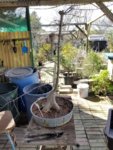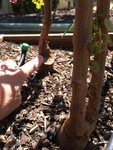Lets break this down into parts.
1. Leaves and twigs power a tree.
2. If you chop a tree it will push new growth.
3. if you choose a leader and cut off all the engine it will suffer.
4. One needs a trunk full of small shoots before chopping.
So look at your tree.
Below the chop there is nothing growing. There is not one shoot to support the trunk after the beheading. If there was, one shoot was kept as the new leader and the others removed. Those that were removed would have nourished that side of the trunk while the chosen shoot was allowed to lengthen.
Chopping a tree is a game of chance that can be thought out in advance. Allow the tree to shoot out profusely the year before the chop. How do we do that?
Reduce the tree by half in year one. In year two when there are many shoots all around the tree and it is healthy, make the chop. Allow everything to grow. You can control the shoots you aren't going to keep by reducing, but do not remove. The next year, year three one can be more selective in the branches, but always remember removal of branches on more than 270 degrees of trunk will cause that part of the trunk to wither. There is just nothing to keep it going.
It also means that rootage on that part will die and it means that you can never develop a 360 degree nebari. Also grafting will not take and buds will never develop. The base of the tree will start to compartmentalize and a hollow will develop vertically. After a few years it will be easy to see which part of the trunk is alive and which part is dead.
In this picture the part of the trunk on the right circled is the old pipe before it was chopped. No shoots on the trunk to support it, no branches, no nothing.

The part on the left of the circled hollow is the new pipe being supported by the extension of the new leader, and the foliage above it. Had the hacker allowed the tree to shoot by a half tree reduction prior to chopping, and leaving that foliage for a year, the right side would still be alive. Then you can build a better nebari and have some branching lower on the trunk. Always better to remove later then to be baffled by how to put it on???

This guy claimed to be the trident maple expert...........sigh






















